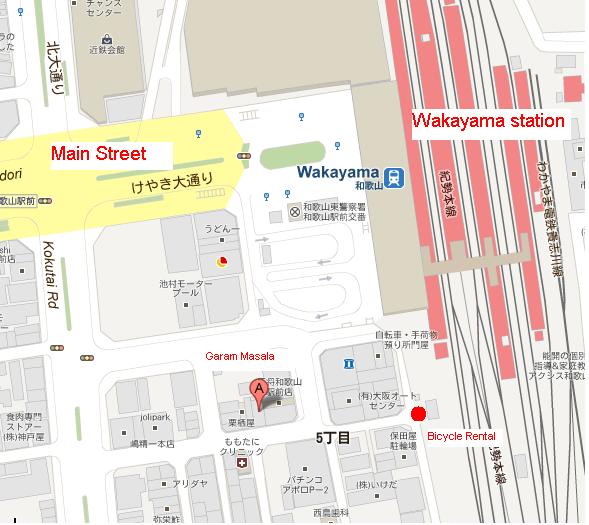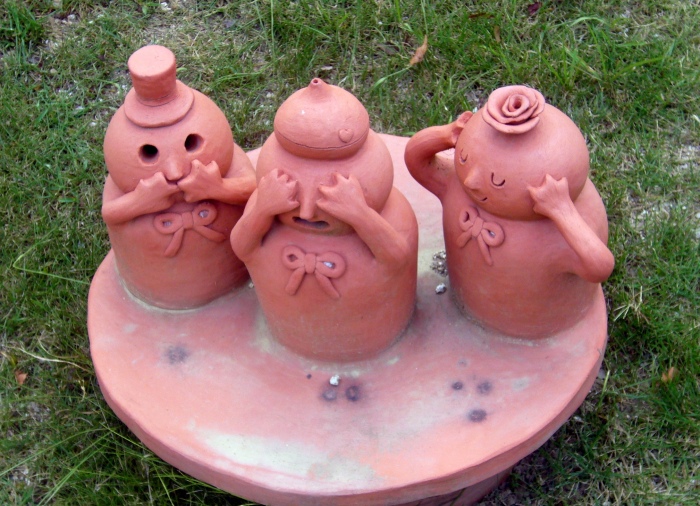Wakayama city, launch point to many of the prefecture’s more famous tourist destinations (see Part 1 and Part 2), may seem to the casual observer a bit grey, industrial and not really worth exiting the station for.
However, while the streets might not be full of charmingly old architecture like Takayama, Wakayama is definitely a town you can enjoy exploring by bike, or by taking a bus, or train to some nearby, unique and interesting places.
(quick note – while I usually try to include photos to illustrate my descriptions of places, in this blog I’m forced to use my words because, having lived in Wakayama for 3 years, I honestly don’t have that many pictures of spots I went to/past all the time.)
Wakayama city and castle
Most things can be reached easily by bus or bike.
Exit the station through the West exit (the exit most commuters will be using). Buses are obvious, parking in the horseshoe directly in front of the station.
For bikes, head left, via a small side street alongside the tracks which leads to a rental car bay that also rents bicycles for 5oo yen a day. At the small office at the front gate ask for a “jitensha” (gee ten sha). You may be expected to write down your name, phone number and address.
The city is now within reach.
Hopefully that wasn’t too much of an effort, but even so, if you feel like a calming cup of chai before launching on your Wakayama adventure there is, too close to even need the bike, the excellent Garam Masala Indo Pak restaurant.
I will never be a good food blogger. I am always happy to see my meal, and usually only remember half way through it that I intended to take some photos of it. Luckily two locals, honeykaot and cookpad have less impatient natures and have taken some great pictures of the kind of meal you can expect.
Lunch specials are quite good, with a chicken or vegetarian curry, plain naan, drink – including chai, lassi as well as softdrinks – and salad for about 750 yen, with 4 levels of spiciness ranging from 0 to 3 (probably should be Indian or Pakistani to eat this). Also recommended are their samusas with green curry.
Garam Masala has long been a favourite eating spot for both Japanese and the local gaijin population. The food is generous and tasty, the tables wide, the atmosphere relaxed and welcoming and the softly playing Bollywood music videos hypnotic. If you read my Culture Shock Survey you will probably recognise the two Nepalese waiters.
Feeling better on a full stomach, head back to the station. The huge, hard to miss main street, Keyaki odori (highlighted in yellow on the above map) leads directly to Wakayama castle in an easy 10 minute ride along wide footpaths. Any bus leaving from platform 2 will also go past the castle.
Wakayama castle sits atop a curved hump of land, said to resemble a crouching tiger. Maybe the image was reinforced due to the nature of the samurai here and their frequent clashes with neighbouring Osaka.
What you may not know is that Wakayama city once had two castles. Ota-jo was very close to where the station is now, and if you exit from the eastern end you will soon be walking through where its walls once stood until a failed siege against Hideyoshi, smasher of castles and Buddhist enclaves. Nothing but a nest of thin streets, a large internet cafe and one of Japan’s rare Subways is left.
Wakayama castle itself is a re-creation. Like many cities in Japan, WW2 firebombing incinerated most of the buildings here including the National Treasure designated castle, leaving only the magnificent, tiered rock walls and a single gate. A shrine honouring the prefecture’s famous Shogun, Yoshimune and the sword he gifted it, were also lost.
After the war, the citizens of Wakayama collected money to rebuild their beloved icon.
Reconstructed castles in Japan are often dismissed as ugly and concrete, some abandoning authenticity altogether and installing elevators (I’m looking at you Osaka-jo). And while the interior of Wakayama castle may not live up to the standards of some, it does have a large collection of guns and cannons, Wakayama being one of the first parts of Japan to reverse-engineer the Portuguese weapons and make their own.
Even if you don’t go into the castle museum (350 yen adult, 170 kids), the grounds are extensive, well-shaded, (full of cats) and good to hike around or hop over the deep-set stepping stones in the Dani Japanese garden for some thick macha (450 yen). I love walking alongside the massive, walls, older than colonised Australia, and feeling utterly dwarfed.
Directly north of the castle is the Daiwa Roynet hotel, that supports a bookstore with a reasonable English section (2nd floor). Biking along past the Roynet, over canals that once fed the castle’s second moat, you will find the covered arcades of Burakuricho, the old shopping district. You may not find anything you particularly want to buy here, but it’s an interesting area to bike or walk around, taking note of the many hole in the wall (sometimes literally) bars and cafes, and peeking down tiny side-streets which sometimes harbour rich-looking vehicles, guarded by men in dark suits, wearing sunglasses.
Keep a look out and see if you can find the shrine with a torii gate that was burnt at its base in the fires that destroyed the castle.
If you find yourself near the station around 8pm you may find a door, leading up a steep staircase to a tiny maid-cafe called CandyPop cafe tucked in a street near the bike rentals. I went there once with my female, Japanese coworkers, and we weren’t exactly their usual customers, but we had a reasonable 500 yen cocoa, with (allegedly) Pikachu drawn in the foam. They are also the organisers of the semi-regular Cosplay events in Wakayama, which I will describe in better detail in Part 4.
Kiifudoki no oka ancient tombs
On the other side of Wakayama station, at a more strenuous biking distance of 4.2 kms (2.6 miles), is a park where Jomon era burial mounds have been, and continue to be, excavated.
Their website, though entirely in Japanese, contains a good map of the hilly grounds, marking out the archaeological sites. The fully uncovered tombs, called kofun, can be entered, as long as you aren’t claustrophobic, while large blue tarps will warn you away from the sensitive, still-being-dug areas. There are also examples of more modern historic high, straw-thatched roofed buildings around the park.
Expect a good cardio workout walking around the park, as the paths are a little steep. But there are frequent benches, and the view from the top of the hill is worth it.
While entry to Kiifudoki no oka is free, entry to the excellent, little museum, full of interesting artifacts including Haniwa which are little clay sculptures from the 4th century that Animal Crossing have ripped off AND a mammoth skull, incurs a whole 190 yen fee for adults, 90 yen for uni students and free for highschool and younger.
If a bike ride seems a little much, there is a 15 minute, 300 yen, direct bus from the station, east entrance, platform 5, buses 90 or 94, and a 5 minute walk from the bus stop (which will be the final stop). See the above link for the exact timetable.
Kuroe laquer
Kuroe might be stretching things a bit, technically being part of Kainan city, however, with only a 10 minute train ride from Wakayama station, it doesn’t feel like much of a journey.
15 minute walk from the station to the lacquer-ware museum, Uruwashi-Kan, doesn’t feel that hard either. The houses are predominately built from dark-stained wood, and are built at an angle, making “a unique kind of scenery… where the houses standing next to each other look like teeth of a saw.” The small town is traditional in look and feel.
At Uruwashi, if you have made a reservation in advance, you can try your hand at makie (ma ki eh), decorating your own piece of laquer-ware, either the black as tar version, or the red ‘negoro’ type.
Under the (bemused?) eyes of a craftsman, we sketched out our designs, before carefully laying down lines of glue, and then sprinkling onto that the gold, silver and other coloured dusts. I would like to say my design looked as good as the examples on their page, but the master could only help so much. Never the less, it was a lot of fun, a chance to experience some culture and make a cute souvenir for my family,
Phone: 073-482-0322. Individuals or small groups on Sundays or Saturdays between 1-3pm (get there before 2. Second Sunday of the month is closed).
Small round trays: 700 yen, large round trays: 1000 yen, bento boxes (my mother uses hers as a jewellery box): 1400 yen.
Bonus: Tama-train
I have tried to keep this list to things I’ve personally done, and enjoyed, but unfortunately I somehow have never taken the cat-printed train from Wakayama-station along Nankai line (platform 9) to Kishi station to see the famous (frequently sleepy) Tama, the cat station master. You should though, and write a blog and tell me how cute Tama-chan is.
Here’s a link to some more information.
Part 4, final installment, will detail some fantastic but strictly seasonal events that you might have to come back to Wakayama twice for.











What is with the blue plastic bags, are they covering something special, just curious. Another awesome post, my family loves making samosas so i would totally love eating at garam masala. Looking forward to more.
LikeLike
The blue tarps are to keep the rain off the excavations I think. They are still digging up some of the old tombs around there. Your family makes samosas!! Lucky~~
LikeLike